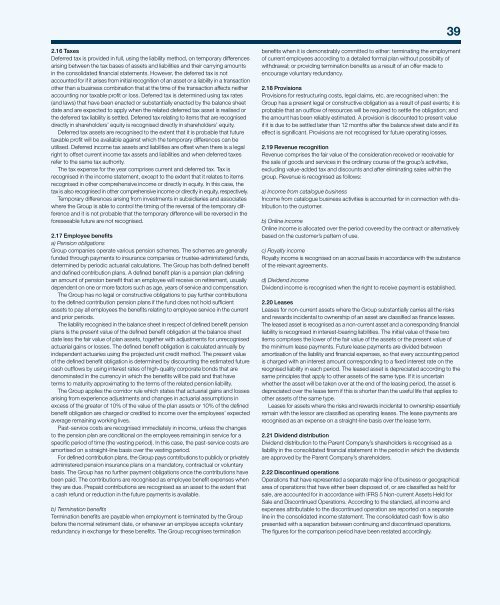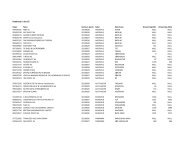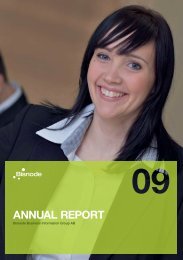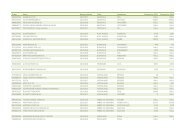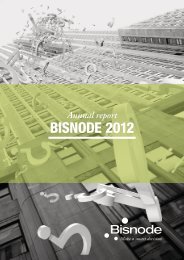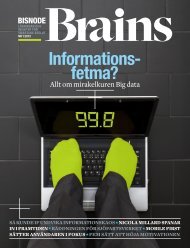Download PDF version - Bisnode
Download PDF version - Bisnode
Download PDF version - Bisnode
You also want an ePaper? Increase the reach of your titles
YUMPU automatically turns print PDFs into web optimized ePapers that Google loves.
2.16 Taxes<br />
Deferred tax is provided in full, using the liability method, on temporary differences<br />
arising between the tax bases of assets and liabilities and their carrying amounts<br />
in the consolidated financial statements. However, the deferred tax is not<br />
accounted for if it arises from initial recognition of an asset or a liability in a transaction<br />
other than a business combination that at the time of the transaction affects neither<br />
accounting nor taxable profit or loss. Deferred tax is determined using tax rates<br />
(and laws) that have been enacted or substantially enacted by the balance sheet<br />
date and are expected to apply when the related deferred tax asset is realised or<br />
the deferred tax liability is settled. Deferred tax relating to items that are recognised<br />
directly in shareholders’ equity is recognised directly in shareholders’ equity.<br />
Deferred tax assets are recognised to the extent that it is probable that future<br />
taxable profit will be available against which the temporary differences can be<br />
utilised. Deferred income tax assets and liabilities are offset when there is a legal<br />
right to offset current income tax assets and liabilities and when deferred taxes<br />
refer to the same tax authority.<br />
The tax expense for the year comprises current and deferred tax. Tax is<br />
recognised in the income statement, except to the extent that it relates to items<br />
recognised in other comprehensive income or directly in equity. In this case, the<br />
tax is also recognised in other comprehensive income or directly in equity, respectively.<br />
Temporary differences arising from investments in subsidiaries and associates<br />
where the Group is able to control the timing of the reversal of the temporary difference<br />
and it is not probable that the temporary difference will be reversed in the<br />
foreseeable future are not recognised.<br />
2.17 Employee benefits<br />
a) Pension obligations<br />
Group companies operate various pension schemes. The schemes are generally<br />
funded through payments to insurance companies or trustee-administered funds,<br />
determined by periodic actuarial calculations. The Group has both defined benefit<br />
and defined contribution plans. A defined benefit plan is a pension plan defining<br />
an amount of pension benefit that an employee will receive on retirement, usually<br />
dependent on one or more factors such as age, years of service and compensation.<br />
The Group has no legal or constructive obligations to pay further contributions<br />
to the defined contribution pension plans if the fund does not hold sufficient<br />
assets to pay all employees the benefits relating to employee service in the current<br />
and prior periods.<br />
The liability recognised in the balance sheet in respect of defined benefit pension<br />
plans is the present value of the defined benefit obligation at the balance sheet<br />
date less the fair value of plan assets, together with adjustments for unrecognised<br />
actuarial gains or losses. The defined benefit obligation is calculated annually by<br />
independent actuaries using the projected unit credit method. The present value<br />
of the defined benefit obligation is determined by discounting the estimated future<br />
cash outflows by using interest rates of high-quality corporate bonds that are<br />
denominated in the currency in which the benefits will be paid and that have<br />
terms to maturity approximating to the terms of the related pension liability.<br />
The Group applies the corridor rule which states that actuarial gains and losses<br />
arising from experience adjustments and changes in actuarial assumptions in<br />
excess of the greater of 10% of the value of the plan assets or 10% of the defined<br />
benefit obligation are charged or credited to income over the employees’ expected<br />
average remaining working lives.<br />
Past-service costs are recognised immediately in income, unless the changes<br />
to the pension plan are conditional on the employees remaining in service for a<br />
specific period of time (the vesting period). In this case, the past-service costs are<br />
amortised on a straight-line basis over the vesting period.<br />
For defined contribution plans, the Group pays contributions to publicly or privately<br />
administered pension insurance plans on a mandatory, contractual or voluntary<br />
basis. The Group has no further payment obligations once the contributions have<br />
been paid. The contributions are recognised as employee benefit expenses when<br />
they are due. Prepaid contributions are recognised as an asset to the extent that<br />
a cash refund or reduction in the future payments is available.<br />
b) Termination benefits<br />
Termination benefits are payable when employment is terminated by the Group<br />
before the normal retirement date, or whenever an employee accepts voluntary<br />
redundancy in exchange for these benefits. The Group recognises termination<br />
39<br />
benefits when it is demonstrably committed to either: terminating the employment<br />
of current employees according to a detailed formal plan without possibility of<br />
withdrawal; or providing termination benefits as a result of an offer made to<br />
encourage voluntary redundancy.<br />
2.18 Provisions<br />
Provisions for restructuring costs, legal claims, etc. are recognised when: the<br />
Group has a present legal or constructive obligation as a result of past events; it is<br />
probable that an outflow of resources will be required to settle the obligation; and<br />
the amount has been reliably estimated. A provision is discounted to present value<br />
if it is due to be settled later than 12 months after the balance sheet date and if its<br />
effect is significant. Provisions are not recognised for future operating losses.<br />
2.19 Revenue recognition<br />
Revenue comprises the fair value of the consideration received or receivable for<br />
the sale of goods and services in the ordinary course of the group’s activities,<br />
excluding value-added tax and discounts and after eliminating sales within the<br />
group. Revenue is recognised as follows:<br />
a) Income from catalogue business<br />
Income from catalogue business activities is accounted for in connection with distribution<br />
to the customer.<br />
b) Online income<br />
Online income is allocated over the period covered by the contract or alternatively<br />
based on the customer’s pattern of use.<br />
c) Royalty income<br />
Royalty income is recognised on an accrual basis in accordance with the substance<br />
of the relevant agreements.<br />
d) Dividend income<br />
Dividend income is recognised when the right to receive payment is established.<br />
2.20 Leases<br />
Leases for non-current assets where the Group substantially carries all the risks<br />
and rewards incidental to ownership of an asset are classified as finance leases.<br />
The leased asset is recognised as a non-current asset and a corresponding financial<br />
liability is recognised in interest-bearing liabilities. The initial value of these two<br />
items comprises the lower of the fair value of the assets or the present value of<br />
the minimum lease payments. Future lease payments are divided between<br />
amortisation of the liability and financial expenses, so that every accounting period<br />
is charged with an interest amount corresponding to a fixed interest rate on the<br />
reognised liability in each period. The leased asset is depreciated according to the<br />
same principles that apply to other assets of the same type. If it is uncertain<br />
whether the asset will be taken over at the end of the leasing period, the asset is<br />
depreciated over the lease term if this is shorter than the useful life that applies to<br />
other assets of the same type.<br />
Leases for assets where the risks and rewards incidental to ownership essentially<br />
remain with the lessor are classified as operating leases. The lease payments are<br />
recognised as an expense on a straight-line basis over the lease term.<br />
2.21 Dividend distribution<br />
Dividend distribution to the Parent Company’s shareholders is recognised as a<br />
liability in the consolidated financial statement in the period in which the dividends<br />
are approved by the Parent Company’s shareholders.<br />
2.22 Discontinued operations<br />
Operations that have represented a separate major line of business or geographical<br />
area of operations that have either been disposed of, or are classified as held for<br />
sale, are accounted for in accordance with IFRS 5 Non-current Assets Held for<br />
Sale and Discontinued Operations. According to the standard, all income and<br />
expenses attributable to the discontinued operation are reported on a separate<br />
line in the consolidated income statement. The consolidated cash flow is also<br />
presented with a separation between continuing and discontinued operations.<br />
The figures for the comparison period have been restated accordingly.


